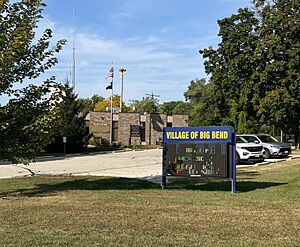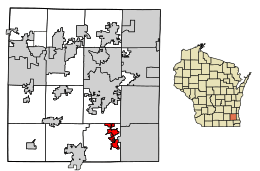Big Bend, Waukesha County, Wisconsin facts for kids
- There are some other places named: Big Bend.
Quick facts for kids
Big Bend, Wisconsin
|
|
|---|---|
|
Village
|
|

Village hall
|
|

Location of Big Bend in Waukesha County, Wisconsin.
|
|
| Country | |
| State | |
| County | Waukesha |
| Area | |
| • Total | 3.30 sq mi (8.54 km2) |
| • Land | 3.25 sq mi (8.42 km2) |
| • Water | 0.05 sq mi (0.12 km2) |
| Population
(2020)
|
|
| • Total | 1,483 |
| • Density | 450.77/sq mi (174.03/km2) |
| Time zone | UTC-6 (Central (CST)) |
| • Summer (DST) | UTC-5 (CDT) |
| ZIP Code |
53103
|
| Area code(s) | 262 |
| FIPS code | 55-07200 |
| GNIS feature ID | 1582806 |
Big Bend is a small village in Waukesha County, Wisconsin, in the United States. In 2020, about 1,483 people lived there. It's a quiet place known for its connection to the Fox River.
Contents
History of Big Bend
Big Bend got its name from the local indigenous peoples (Native Americans). They named it because the Fox River makes a big turn or "bend" in this area.
The first European-American settlers arrived in 1846. They came from a town called Andover, Vermont.
Geography of Big Bend
Big Bend is located at 42°53′16″N 88°12′41″W / 42.88778°N 88.21139°W. It covers a total area of about 3.15 square miles (8.16 square kilometers). Most of this area is land, with a small part being water.
The village sits right on the banks of the Fox River. The name "Big Bend" perfectly describes the spot. Here, the river changes its path, turning from flowing east to flowing south.
Population and People
| Historical population | |||
|---|---|---|---|
| Census | Pop. | %± | |
| 1930 | 309 | — | |
| 1940 | 298 | −3.6% | |
| 1950 | 480 | 61.1% | |
| 1960 | 797 | 66.0% | |
| 1970 | 1,148 | 44.0% | |
| 1980 | 1,345 | 17.2% | |
| 1990 | 1,299 | −3.4% | |
| 2000 | 1,278 | −1.6% | |
| 2010 | 1,290 | 0.9% | |
| 2020 | 1,483 | 15.0% | |
| U.S. Decennial Census | |||
How Many People Live Here?
In 2010, there were 1,290 people living in Big Bend. These people lived in 486 different homes. The village had about 415 people per square mile.
Most of the people in Big Bend were White (97.9%). A small number were African American, Native American, or Asian. About 2.3% of the population was Hispanic or Latino.
Families and Ages
Many homes in Big Bend (35.4%) had children under 18 living there. Most homes (63.4%) were married couples living together.
The average age of people in the village was about 40.8 years old. About 23.9% of residents were under 18. About 11.1% were 65 years old or older. The number of males and females in the village was almost equal.
Schools in Big Bend
Big Bend has good schools for its young residents.
Christ Lutheran School is a private school in Big Bend. It teaches students from Pre-Kindergarten (age 3) up to 8th grade. It is part of the Wisconsin Evangelical Lutheran Synod.
The village is also part of the Mukwonago Area School District. Big Bend Elementary School is located right in the village. It serves students from Kindergarten to 6th grade. After elementary school, older students go to Parkview Middle School. Then, they attend Mukwonago High School.
The Story of Hygena Spring
In the late 1800s, Waukesha County was famous for its many clean springs. People called it the "Saratoga of the West." Many believed the spring water had special healing powers. Thousands of visitors came to drink the water and visit bath houses.
A Big Idea for Water
Around 1890, a businessman named James M. McElroy had a big idea. He wanted to send water from a spring in Waukesha to the Columbian Exposition in Chicago. This was a huge world's fair, and Chicago needed lots of clean water. The Chicago River was polluted, and people worried about a water shortage. McElroy planned to build a pipe over 100 miles long! He hoped to earn a lot of money by selling the spring water.
A Surprise at the Spring
On May 12, 1892, McElroy sent a train full of workers and pipes to the spring. But the local villagers were not happy. They were worried that taking so much water would harm their own springs. So, they met the train with cannons and rifles! They told the workers to leave the spring alone. The workers had to turn back.
After this, McElroy bought another spring. This new spring was outside of Waukesha, in what is now Big Bend. He named it Hygena Spring II. McElroy did build his long pipe to Chicago. But when the water finally reached the exhibition, some people said it tasted old and flat.
Today, Hygena Spring II still flows. It is on private land, but the owners often let people visit and enjoy the water.
Notable People from Big Bend
Many interesting people have connections to Big Bend:
- David Craig was a politician from Wisconsin. Politicians help make laws and lead the government.
- Hal Peck was a professional baseball player.
- Delbert K. Smith was another Wisconsin politician who was born in Big Bend.
- James Tormey also served as a politician in Wisconsin.
- Ellen Hunnicutt is a well-known author.
- David J. Eicher is an editor and writer. He is famous for making astronomy and space topics easy for everyone to understand.
See also
 In Spanish: Big Bend (Wisconsin) para niños
In Spanish: Big Bend (Wisconsin) para niños

